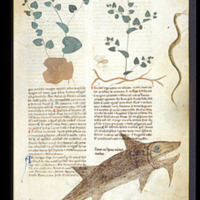Ambergris
Dublin Core
Title
Subject
Description
The origin of ambergris is still shrouded in mystery. Although it has appeared from time to time over many centuries on European shores, such as Portugal, Spain, France, and England, ambergris is not a commonly-found local substance in Europe. As an exotic animal material and a valuable commodity in high demand, ambergris was imported to Europe from distant lands, such as Asia, Africa, and the Americas via trade routes.
Ambergris was so valuable that it served as a prestigious gift among European royals and was also sometimes mentioned in inventories of wills, along with gold and silver, during the sixteenth and seventeenth centuries.
Ambergris was used as a scent fixer (as in the recipe of Ms. Fr. 640) in addition to uses in remedies, whose medicinal value was learned by Europeans from the Arabs.
Source
Fol. 163r – “Perfumer”
They readily put half of amber & half of musk & very little civet, because amber always overtakes the principal scent of musk.
To spare the amber, they readily put a little musk in the white layers, which gives a more forceful scent. But to remove or hide the blackness of the musk, they put in a bit of wheat starch from England, which is perfectly white.
To perfume with white amber in the Portuguese fashion, take a huchau of amber, well broken up. And having put in a small silver bowl a spoonful of flower oil, or lacking that, ben oil, that is to say, a silver spoon that one uses at the table, put in your ambergris & place all on a low fire, and it will melt quickly if your amber is good, & it will remain there without lumps. Once all melted, put in the size of a pine nut of civet, & make it melt, & mix it well together. Next, take your gloves, well-cleaned & well-dried, & dipping the tip of your finger very lightly on the edge of the oil, spread it on the glove, little by little & with patience, & rub the glove between your hands, & trace the fingers & the stitches, one after the other. And leave it to dry. Next, trace again as before until the amber is all laid down.
Contributor
Alan Davidson, "Ambergris," in The Oxford Companion to Food, ed. Tom Jaine (Oxford University Press, 2014), https://www-oxfordreference-com.ezproxy.cul.columbia.edu/view/10.1093/acref/9780199677337.001.0001/acref-9780199677337-e-0050.
Cristina Brito, Vera L. Jordão, and Graham J. Pierce, “Ambergris as an Overlooked Historical Marine Resource: Its Biology and Role as a Global Economic Commodity,” Journal of the Marine Biological Association of the United Kingdom 96, no. 3 (2016): 585–96.
Emily Osterloff, “What is ambergris?” Natural History Museum. https://www.nhm.ac.uk/discover/what-is-ambergris.html.
Karl H. Dannenfeldt, “Ambergris: The Search for Its Origin,” Isis 73, no. 3 (1982): 382–97.
Matthew Wills, "What is Ambergris and Where Does It Come From?" J Stor Daily (Dec. 9, 2015). https://daily.jstor.org/what-is-ambergris-and-where-does-it-come-from/.
Image: Miniature illustration of a sperm whale complementing a text discussing ambergris in medieval manuscript. Salerno, Italy.
Helena Seo, Columbia University
